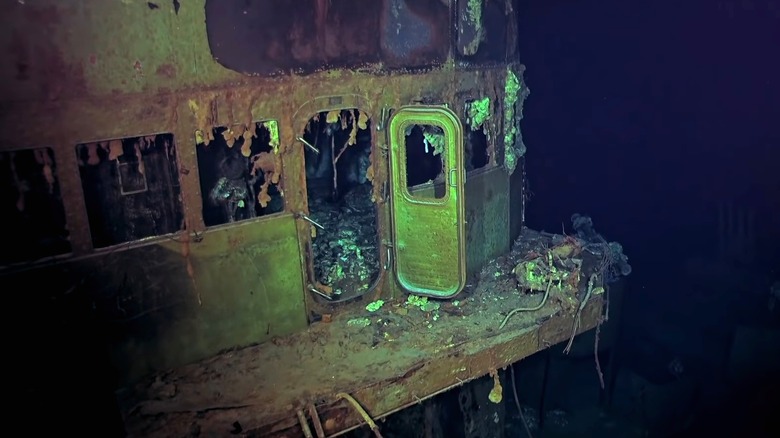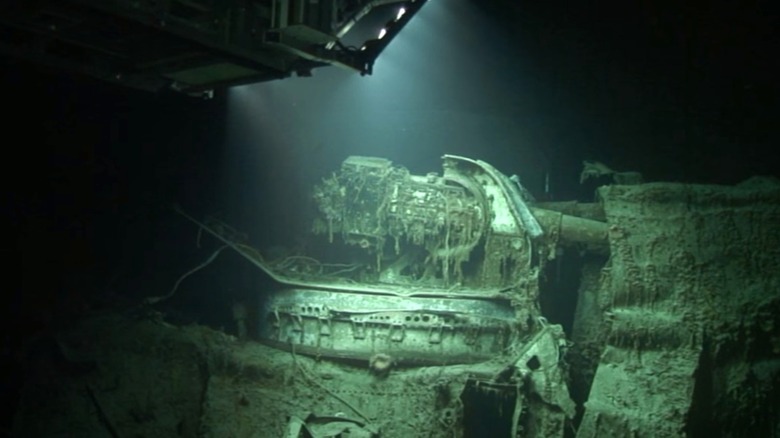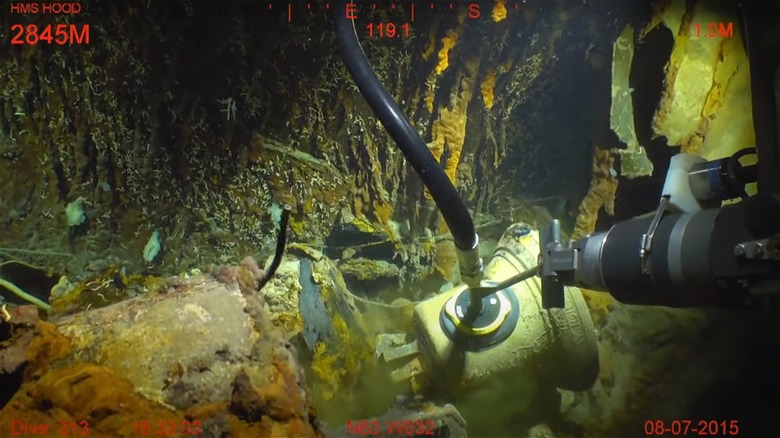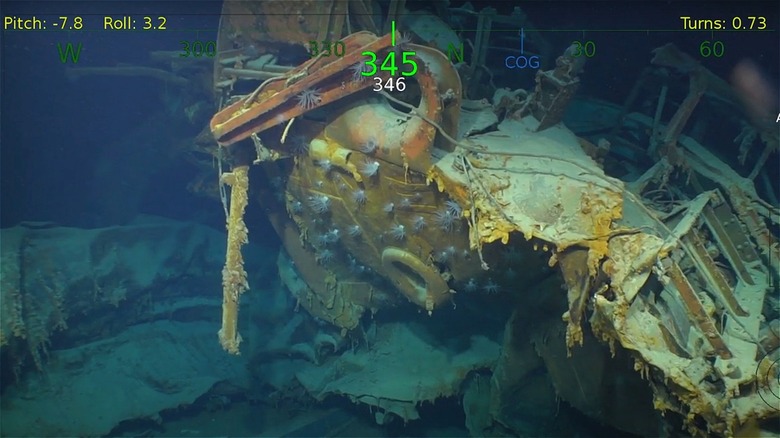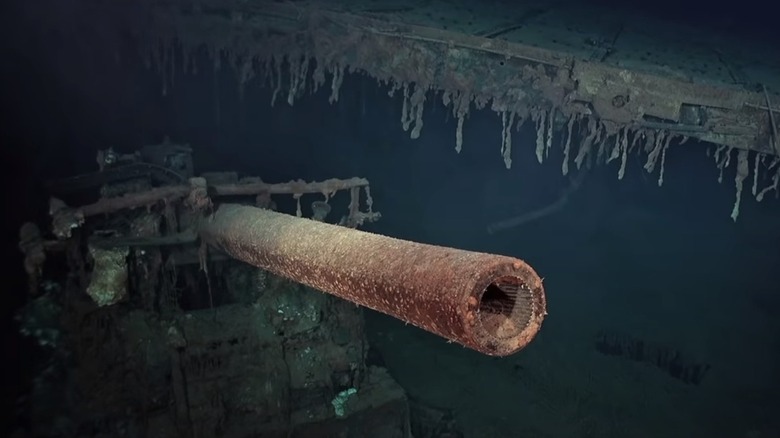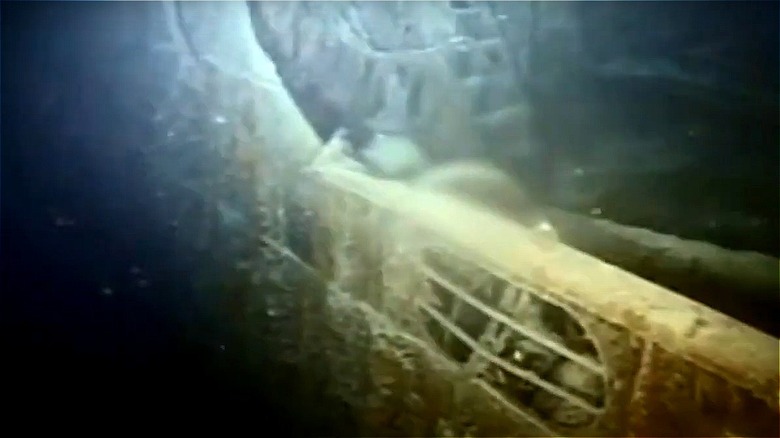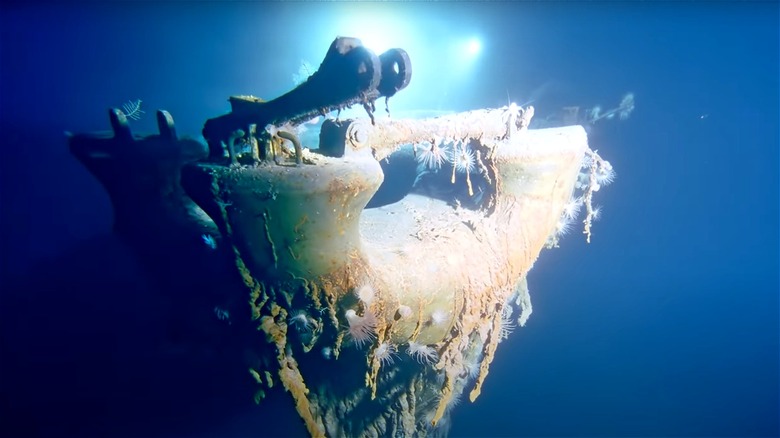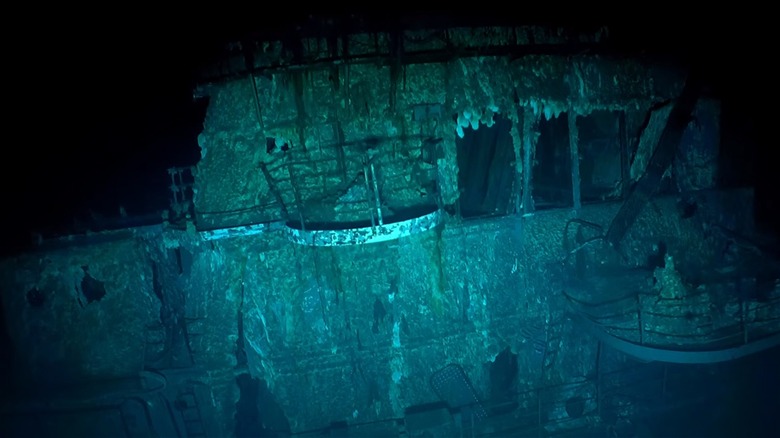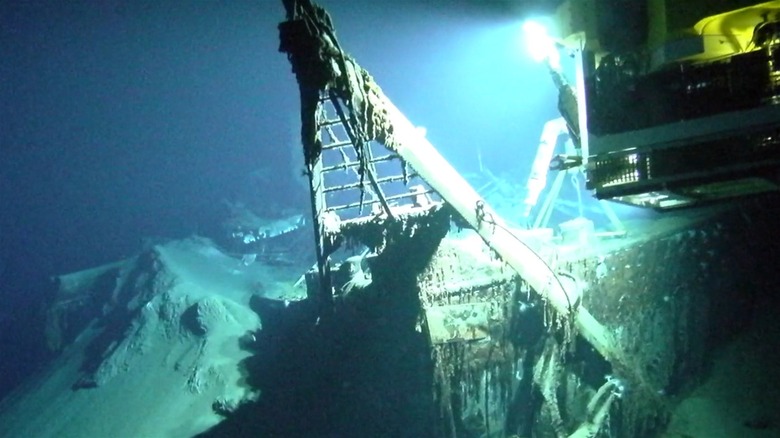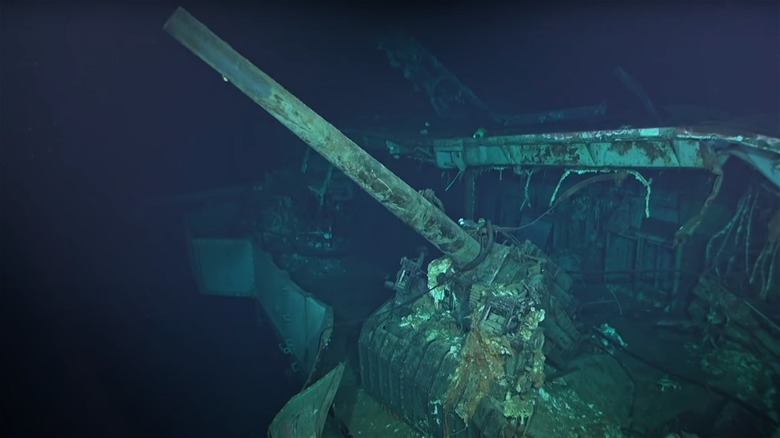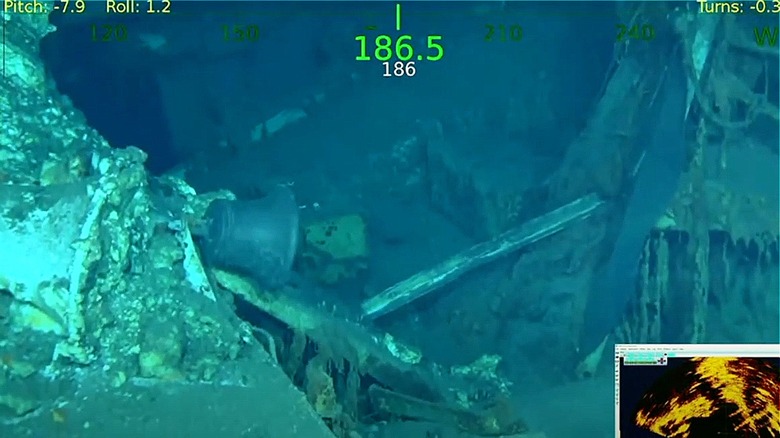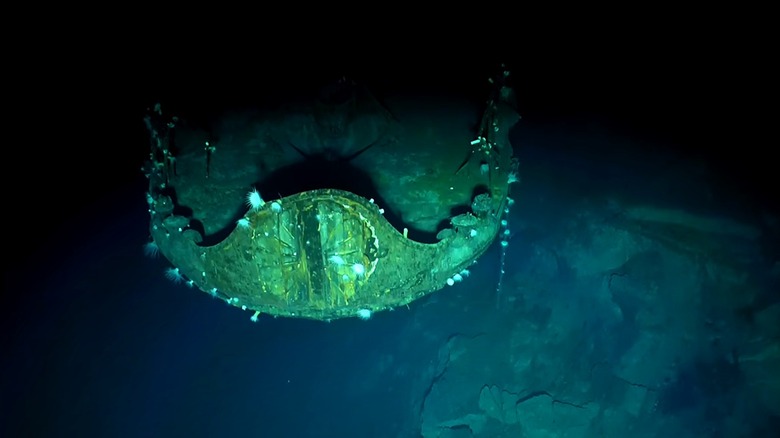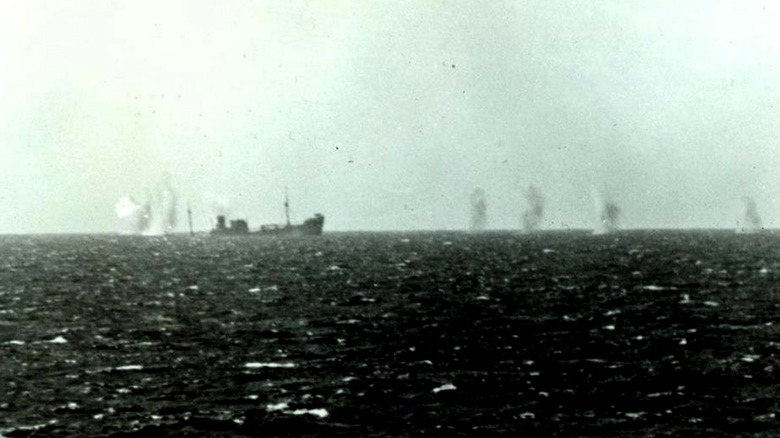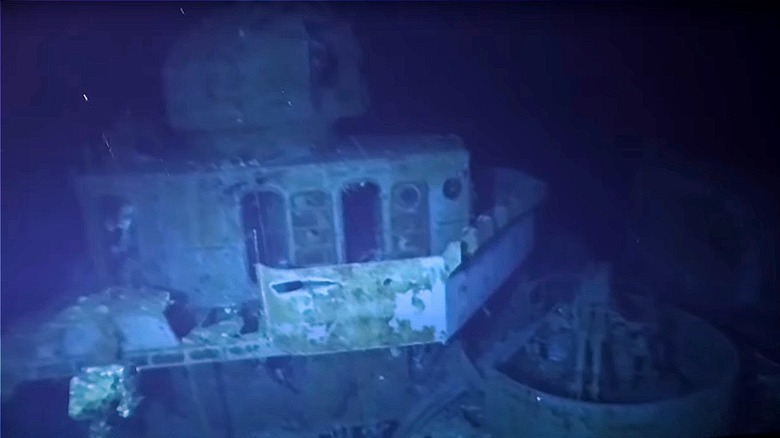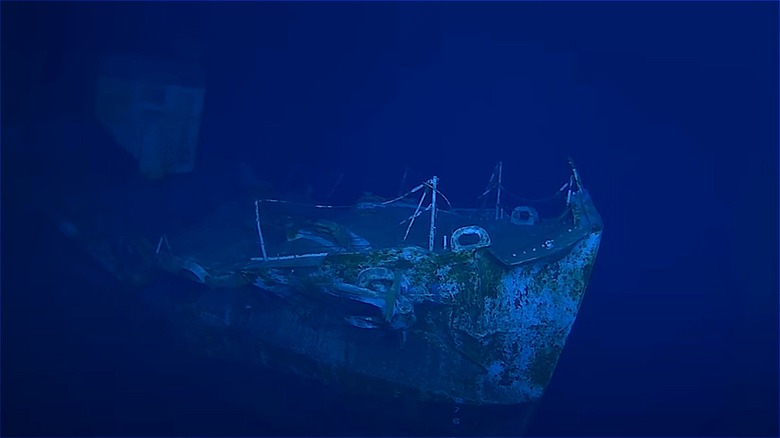The 14 Deepest Shipwrecks Of WWII, Ranked
The Allied and Axis forces lost thousands of ships during World War II, and many of those vessels remain on the sea floor. Those lost ships include the HMS Barham, which lies at about 9,500 feet somewhere in the Mediterranean Sea; the Laconia, which sank to roughly 10,700 feet in the Atlantic; and the SS Ceramic, a steamship that rests 15,200 feet deep some 500 miles west of the Azores — but that's not what we'll be focused on today.
Instead, we are looking only at the wrecks that have been found in the Atlantic, Indian, and Pacific oceans. To study these shipwrecks is to read stories of injury, exposure, starvation, and death. They are haunting reminders of the brutality of warfare and the vast, terrifying power of the ocean that sober us with accounts of heroism and sacrifice. Here are the 14 deepest shipwrecks from World War II.
14. HMAS Sydney II and HSK Kormoran: 8,103 feet and 8,398 feet
HMAS Sydney II was an Australian light cruiser whose performance against the Italian Navy in 1940 made her a symbol of independence to the Australian public. In February 1941, Sydney returned to her namesake harbor, receiving a rapturous welcome from scores of civilians. Over the coming months, Sydney performed escort duties off the Australian coast and into the Indian Ocean, where, on November 19, she sighted what appeared to be the MV Straat Malakka, a Dutch merchant ship.
Sydney approached the vessel and challenged her with searchlight signaling, to which the Malakka responded with maritime flags, making the crew appear to be legitimate. However, when Sydney asked the Malakka to reveal its secret sign, the supposedly naive crew raised a swastika, opened a battery of gun hatches, and opened fire — it was not the Straat Malakka, but the HSK Kormoran, a Nazi auxiliary cruiser.
The ensuing battle was mutually destructive. Kormoran struck Sydney with several torpedoes, killing dozens of men and causing serious fires, while Sydney dealt a fatal blow to Kormoran's funnel, breaking the engine. Sydney drifted into the distance and sank hours later with no survivors. The Kormoran's crew scuttled the ship and dispersed in lifeboats; 318 of the 380-strong crew were rescued and taken prisoner.
In 2008, David Mearns and a team of scientists found Kormoran 8,398 feet under the surface. Days later, the team located the Sydney 12 nautical miles southeast at a depth of 8,103 feet.
13. HMS Hood: 9,334 feet
At 47,000 tons and 860 feet in length, HMS Hood — launched on August 22, 1918 — ranked among the most legendary ships of the interwar period. She was fast, too, hitting speeds of 30 knots. However, by 1939 the Mighty Hood was showing her age. Still, she remained a formidable ship and saw much action in the opening years of World War II, including the destruction of the French fleet at Mers-el-Kébir after the Franco-German Armistice of 1940.
In May 1941, Hood and HMS Prince of Wales were sent to shadow the Bismarck and Prinz Eugen near the Denmark Strait between Iceland and Greenland. The adversaries clashed on the morning of May 24, with Prinz Eugen hitting Hood with a salvo that destroyed a magazine and killed several men. Then, at 6:01 am, the Bismarck fired from some nine miles away, detonating a 100-ton magazine that rocked the Hood from side to side and spewed a massive incendiary oil slick around her. Three minutes later, she disappeared from view. Of her 1,418 crew, only three survived. Shocked and enraged, Churchill ordered that the Bismarck be destroyed at all costs.
A little over 60 years later — in July 2001 — shipwreck hunter David Mearns located the ship roughly 9,334 feet beneath the surface. "Our immediate reaction has been one of surprise at the damage suffered by Hood," Mearns told The Guardian. "It is far worse than any of us had expected."
12. USS Juneau: 13,800 feet
The USS Juneau was lost at the Naval Battle of Guadalcanal in November 1942. She held her own, destroying six enemy torpedo planes with anti-aircraft fire. Afterward, she remained in the area in a group of 13 ships. In the small hours of November 13, a Japanese force of two battleships, one light cruiser, and 11 destroyers steamed toward their position. A battle commenced in a hectic free-for-all, with guns firing at point-blank range in pitch darkness.
The Japanese destroyer Murasame hit Juneau with a torpedo in her portside. Juneau was badly damaged, but she managed to escape the battle. However, as she passed through the Sealark Channel en route to Espíritu Santo, the Japanese submarine I-26 launched three torpedoes, striking Juneau's portside in almost the same place as the Murasame, causing an explosion so great that the ship sank in just 20 seconds.
The loss of the USS Juneau ranks among the U.S. Navy's worst losses of the Second World War, with 687 men perishing in the disaster, including all five of the Sullivan brothers, whose deaths ensured that relatives would never again be posted in the same units.
In March 2018, the RV Petrel found the USS Juneau at a depth of over 13,700 feet.
11. USS Wasp: 14,255 feet
Launched in July 1940, the USS Wasp was an aircraft carrier with a short but eventful life. The ship helped enforce U.S. neutrality in the Atlantic until December 1941, when the United States Navy entered the Battle of the Atlantic, which had been raging since September 1939. In May 1942, Wasp participated in Operation Bowery, an Anglo-American effort to deliver fighter aircraft to Malta. Wasp delivered 47 Supermarine Spitfires to the island, which helped defeat the Nazi siege on November 20, 1942.
After this, Wasp headed west to the Pacific by traversing the Panama Canal, stocking up at San Diego, and arriving in Tonga on July 18. Almost two months later, after numerous engagements with Japanese positions in the South Pacific, the Wasp powered towards Guadalcanal in a formation of warships. Japanese submarine I-19 struck her with two torpedoes, unleashing a terminal fire that caused Captain Forrest Sherman to abandon the ship; hours later, the USS Lansdowne scuttled the Wasp with three torpedoes. 193 of her 2247 crew died.
In March 2019, the RV Petrel located the USS Wasp at a depth of 14,255 feet.
10. SS Gairsoppa: 15,419 feet
On February 16, 1941, the SS Gairsoppa — a British merchant ship — was traveling from Calcutta to London and had reached the Western Approaches carrying 2,600 tons of pig iron, 1,765 tons of tea, 2,369 tons of general cargo, and 200 tons of silver ingots and coins.
The February 16 began inauspiciously as a German plane circled the Gairsoppa, but the day passed without event until around 6 pm when U-101 identified the ship about 300 miles southwest of the Irish coast. The weather was too rough for action, so Commander Ernst Mengersen waited until after 11 pm when he fired two inaccurate salvos. He finally hit the Gairsoppa on his third attempt, causing a lethal fire that sank the ship in 20 minutes.
The men aboard the merchant vessel — a crew of 86 British, Indian, and Chinese sailors — fled the ship in three lifeboats, two of which disappeared in the violent weather. Two weeks later, the remaining lifeboat capsized near the shore of Lizard, Cornwall, killing all but one of the men inside. Richard Hamilton Ayres, the second officer, was the Gairsoppa's sole survivor.
In 2010, the British government tasked Odyssey Marine Exploration with salvaging the Gairsoppa's precious cargo. The following year, the company located the Gairsoppa 15,419 feet below the surface. Over the next few years, Odyssey salvaged over 100 tons of silver worth tens of millions of pounds.
9. Bismarck: 15,700 feet
In May 1941, the Bismarck was steaming toward the French coast with a leaking fuel tank. The Bismarck and the Prinz Eugen had just destroyed HMS Hood, the pride of the British fleet, and Churchill was bent on revenge. The Prime Minister ordered all nearby ships to descend on the Bismarck's position before it got within range of U-boat and Luftwaffe protection.
The German battleship pulled away amidst salvos and air attacks by the Prince of Wales and HMS Victorious, allowing the crew to slow the engines and work on repairs. However, a group of Swordfish torpedo bombers spotted the Bismarck and, after reloading and refueling on HMS Ark Royal, launched an attack that destroyed the ship's rudders, forcing it to steer in wide circles. On the morning of the 27th, two battleships and two cruisers fired hundreds of shells and torpedos at the Bismarck, causing her crew to scuttle the ship with the loss of 2,086 of her 2,200 crew.
On June 8, 1989, Titanic discoverer Dr. Robert Ballard located the Bismarck 600 miles off the coast of Brest. After plunging through the depths, the feared battleship hit a seamount that triggered a landslide, carrying the vessel to a final depth of 15,700 feet.
8. USS Yorktown: 16,650 feet
The USS Yorktown was an aircraft carrier that won three battle stars for her actions during the Battle of the Coral Sea in May 1942, namely her destruction of three minesweepers, four barges, and the destroyer Kikuzuki. However, she barely survived the engagement after a large bomb that exploded below deck, killing or injuring 66 sailors.
Repairs were scheduled to take three months but were expedited based on intelligence about Japanese designs on Midway Island. On May 30, mere weeks after the carnage of the Coral Sea, Yorktown powered toward the North Pacific and made history in perhaps the most decisive naval battle of the war.
On June 4, Yorktown's aircraft struck the carrier Soryu with three 1,000 lb bombs, causing such severe damage that the survivors scuttled her. Nearby, the USS Enterprise sank the Akagi and Kaga carriers, but there was still the Hiryu, and her aircraft — which included a force of 18 Aichi Val dive bombers — descended on the Yorktown, who responded with a fleet of Wildcats. A furious dogfight ensued, but three Japanese aircraft scored direct hits on Yorktown's portside, causing her to list. Later, during rescue efforts, I-168 finished her off with two torpedoes. She sank the following morning, with 141 of Yorktown's crew killed in action.
In June 1998, Robert Ballard, National Geographic, and the US Navy located the ship 16,650 feet beneath the surface.
7. SS City of Cairo: 16,896 feet
The SS City of Cairo was a passenger ship before the British government requisitioned her for the war effort. In October 1942, London ordered the Cairo to ship a 100-ton consignment of silver rupees from Bombay to the English capital, around the Cape of Good Hope. She arrived in South Africa on November 1 and departed soon after, entering the mid-Atlantic en route to Brazil, her penultimate stop.
On the evening of November 6, some 500 miles south of St. Helena, U-68 fired a torpedo into Cairo's stern, cutting the ship's electricity and causing a terrifying panic. A second torpedo struck 20 minutes later, sinking the Cairo by the stern. 293 people manned six lifeboats; 207 of them survived. Those in lifeboat six spoke with Kapitan Karl-Friedrich Merten, who surfaced the U-68 to inquire about the ship he had just destroyed. Before departing, he said, "Goodnight, and sorry for sinking you."
The merchant ship may have been lost to history had it not been for her valuable cargo. In 2012, Deep Ocean Search located the City of Cairo at a depth of 16,896 feet. By September of the following year, the company recovered some $50 million worth of silver coins, ranking it among the most valuable cargo wrecks ever found.
6. USS Hornet, 17,716 feet
The USS Hornet had a proud record in the Pacific theater, launching the Doolittle Raid and fighting in the Battle of Midway, where she helped destroy the Japanese cruiser Mikuma. After Midway, Hornet stayed in Pearl Harbor until August 27, 1942, when she left for the Solomon Islands and Guadalcanal. Hornet patrolled the area over the next two months and engaged in numerous actions, including the Buin-Faisi-Tonolai raid and the skirmish that sank the USS Wasp.
The Hornet evaded serious damage until the Battle of the Santa Cruz Islands in late October 1942, when the U.S. forces met a larger Japanese force. Hornet attacked Shokaku, Terutsuki, and Chikuma, but the U.S. carrier took several strikes from numerous bomber aircraft, causing irreparable damage and killing 140 men. After several failed attempts to scuttle the ship, U.S. forces dispersed and the Japanese destroyers Akigumo and Makigumo moved in, sinking the USS Hornet on October 26.
In February 2019, the RV Petrel — a research ship then owned by Microsoft co-founder Paul Allen — discovered the USS Hornet 17,716 feet under the surface.
5. USS Indianapolis,18,000 feet
On July 26, 1945, USS Indianapolis arrived at Tinian, Northern Mariana Islands. They didn't know it, but her crew had delivered enriched uranium and other components that would make the Little Boy atomic bomb, which devastated Hiroshima 12 days later on August 6.
Her next mission was to rendezvous in the Leyte Gulf, for which she departed on July 29. The Indianapolis was roughly halfway to her destination when, 15 minutes after midnight on July 30, she was struck by two torpedoes from the Japanese submarine I-58, tearing through the bow and midship, splitting the ship length ways.
The Indianapolis was gone in 12 minutes, taking 300 sailors down with her. The remaining 900 men floated on the surface, holding each other in groups and clinging to debris. Over the next four days and five nights, around 600 men were lost to drowning, starvation, exposure, suicide, and dozens of shark attacks.
American authorities learned of the sinking only on the morning of August 2, when Lieutenant Chuck Gwinn spotted the survivors during an aerial patrol. A PBY Catalina flying boat dropped life rafts and, hours later, the USS Cecil Doyle arrived and rescued the men throughout the night.
In March 2018, the RV Petrel discovered the Indianapolis 18,000 feet below the surface.
4. Akagi and Kaga, 18,011 feet
Early in the Pacific war, Admiral Yamamoto made a prescient prediction. As recorded by Britannica, Yamamoto said, "In the first six to twelve months of a war with the United States and Great Britain, I will run wild and win victory upon victory. But then, if the war continues after that, I have no expectation of success."
Yamamoto's appraisal was realized in June 1942, when dozens of ships and hundreds of aircraft of the Japanese and American navies clashed at the Battle of Midway, one of the most important air and sea battles in history. The carriers Akagi, Kaga, Hiryu, and Soryu led the Japanese fleet, and the United States destroyed them all with wave after wave of dive bomber attacks. Japan also lost 3,000 personnel, a heavy cruiser, over 320 planes, and, crucially, the momentum in the Pacific theater. For the Americans, Midway was swift and decisive justice against the ships that wrought havoc at Pearl Harbor, killing some 2,300 sailors and personnel.
In October 2019, the RV Petrel located the wrecks of Akagi and Kaga in over 18,000 feet of water, both lying within the Papahanaumokuakea Marine National Monument.
3. SS Rio Grande, 18,904 feet
The SS Rio Grande was a Nazi blockade runner that used speed and agility to outmaneuver Anglo-American blockades in the Atlantic Ocean. However, in January 1944, USS Omaha and USS Jouett surrounded the Rio Grande off the Brazilian coast in the South Atlantic. American sailors prevented the German crew from scuttling the ship and took them prisoner. Later, they opened fire and sent the Rio Grande to the seabed loaded with copper, tin, cobalt and rubber bales.
The image above is courtesy of the U.S. National Archives and depicts the sinking of the SS Rio Grande by the USS Omaha and USS Jouett in January of 1944.
On November 28, 1996, Blue Water Recoveries found the wreck with side-scanning sonar technology. Just two days later, a remotely operated vehicle confirmed that the Rio Grande was resting at a depth of 18,904 feet, making it the deepest wreck ever found at the time.
In 2020, a series of rust-covered 200 lb blocks washed up on the shores of Texas and Florida. Upon inspection, scientists established that they were rubber bales that had likely broken free from the Rio Grande and spent years floating in the Atlantic current.
2. USS Johnston, 21,180 feet
For over 20 years, the SS Rio Grande was the deepest shipwreck ever found. That all changed in October 2019, when RV Petrel found what appeared to be the USS Johnston at a depth of approximately 20,400 feet. It was hard to tell, though, because the wreck was completely torn apart.
The Johnston sank during the Battle off Samar on October 25, 1944. Commander Ernest Evans charged the destroyer towards a greater Japanese force, sinking a cruiser before receiving mortal injuries after a nearly three-hour exchange. She sank directly into the Philippine Trench, which reaches a maximum depth of 34,578 feet — only 1,300 feet shallower than the Challenger Deep, which is the deepest point on Earth.
The USS Johnston's wreck was confirmed in April 2021, when explorer Victor Vescovo surveyed the wreck in his submersible Limiting Factor, establishing its depth at an abyssal 21,180 feet.
1. USS Samuel B. Roberts, 22,621 feet
The USS Johnston was not the only ship to sink during the Battle off Samar. There was also the USS Samuel B. Roberts, the destroyer escort that sunk the Chokai and damaged the Chikuma before the greater Japanese force overwhelmed her, killing 89 crew and leaving 135 survivors stranded on life rafts for some 50 hours. The ship's bravery was so remarkable that she is known as "the destroyer that fought like a battleship."
Victor Vescovo located the USS Samuel B. Roberts in June 2022 at a depth of 22,621 feet. "The Sammy B engaged the Japanese heavy cruisers at point blank range and fired so rapidly it exhausted its ammunition," Vescovo told the BBC. "It was down to shooting smoke shells and illumination rounds just to try to set fires on the Japanese ships, and it kept firing. It was just an extraordinary act of heroism.
